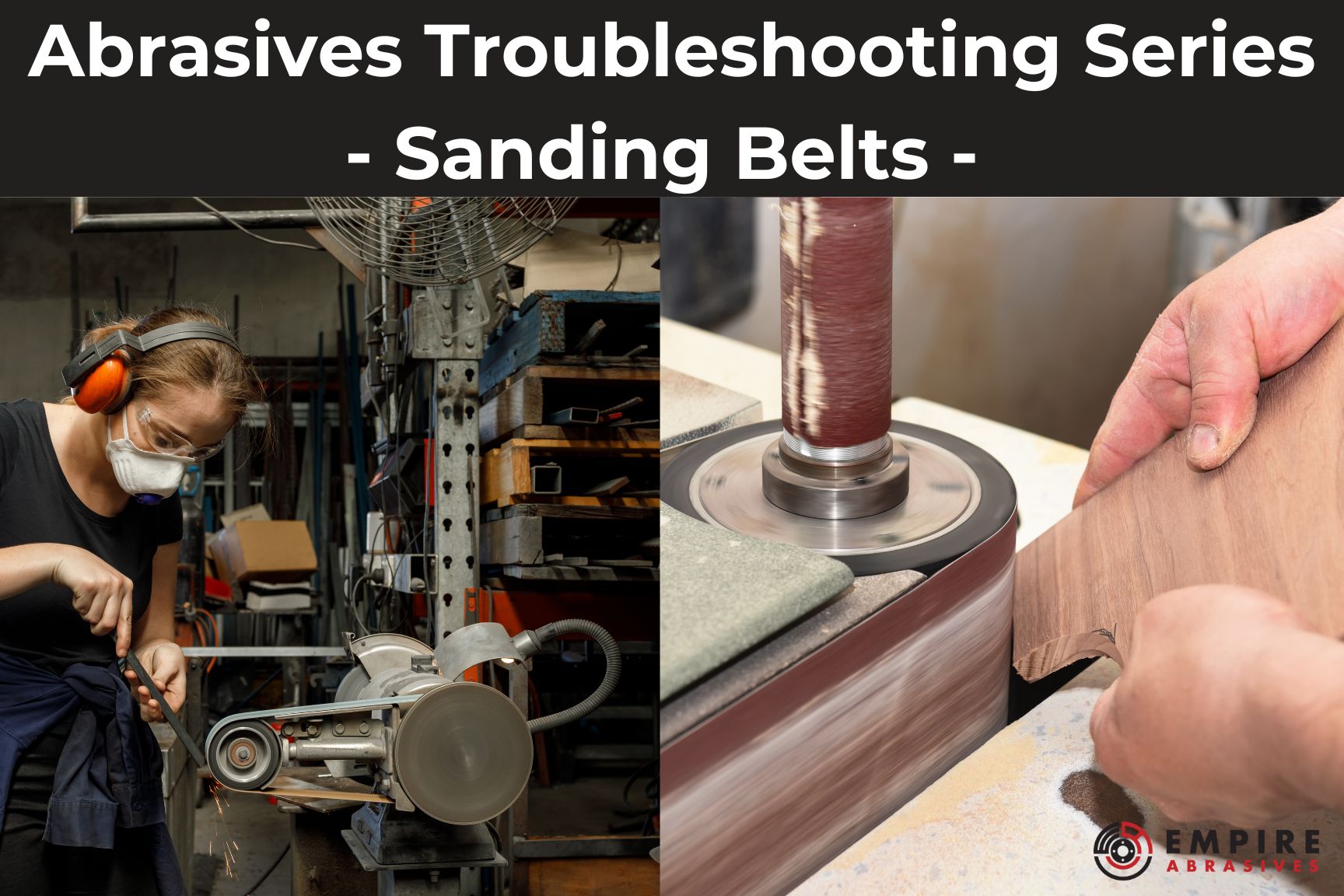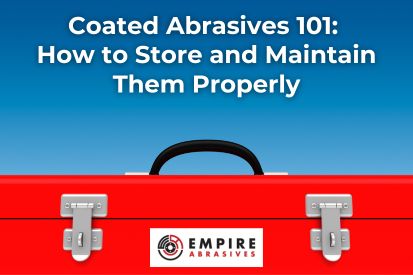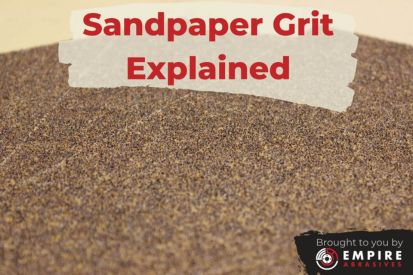<!–

–>

We wanted to create a resource for our customers to
troubleshoot common abrasive product issues. Our team is available during
normal office hours to talk to you on phone, email, or website chat, but this
guide was created for those that like to troubleshoot on their own. This
article will be the first in a series of abrasive tool troubleshooting posts,
focusing on Sanding
Belts.
In this post we will discuss common sanding belt issues,
their causes, and arm you with troubleshooting tips to maintain your sanding
belts and make sure you are creating the best finished product with them.
About Sanding Belts
Sanding belts are some of the most versatile abrasive
products available. They are constructed with long strips of abrasive material,
typically cloth or paper, coated with abrasive grains of various types,
including aluminum oxide, silicon carbide, zirconia, and ceramic. They are
designed to be mounted on belt sanders, which use the continuous motion of the
belt to remove material, smooth surfaces, or create a desired finish.
Sanding belts are commonly used in woodworking,
metalworking, automotive, and other industries and hobbies for applications
such as shaping, material removal, deburring, finishing, and polishing. They
can be used on a wide range of materials, including wood, metal, plastic, and
composite materials.
Using sanding belts correctly is crucial for achieving your desired
results, ensuring safety, and prolonging the life of the abrasive product.
Proper usage includes selecting the appropriate grit size, maintaining the
correct tension, and using appropriate techniques to avoid common issues such
as uneven wear or belt tracking problems.
Common Sanding Belt Issues
- Belt breakage
- Uneven wear
- Grit shedding
- Belt tracking issues
Causes and Troubleshooting
1 – Tension Adjustment
Important of proper tension
Setting and maintaining the correct tension of your sanding
belt is crucial for extending your belt life and getting optimal performance
out of it. Too little or too much tension can lead to belt breakage, uneven
wear, and overall reduced efficiency.
How to identify incorrect tension
Signs that you may notice from incorrect tension include
belt slippage, poor sanding results, and/or excessive noise.
Adjusting the belt tension
Every belt sander is different, so the first thing you should
do is refer to your tool’s manual which should have specific guidelines on
setting proper tension. Gradually adjust the tension of the belt sander until
you can tell it is running smoothly and securely without making excessive noise
or slipping.
2 – Proper Belt Storage and Handling
Important of proper storage and handling
Sanding belts, and all coated abrasives, can degrade over
time due to improper storage or handling. Exposure to extreme temperatures,
humidity, and/or direct sunlight can break down the adhesives holding the
abrasives together and the belt itself.
Tips for Proper Sanding Belt Storage
- Store belts away from direct sunlight, in a
cool, dry place - Keep belts away from other heat or moisture sources (heaters, humidifiers, etc.)
- Handle belts in a way that avoids kinking or
creasing the belt - If possible, hang the belts rather than store
them in a closed container
For
more information – Coated
Abrasives 101: How to Store and Maintain Them Properly

3 – Choosing the Right Grit
Important of grit choice
The size of the grit (coarseness) is one of the most
important factors in choosing an abrasive for most projects. Using the wrong
grit size can damage surfaces, cause uneven wear, build up excessive heat, or
lead to an unsatisfactory finish.
How to choose the right grit size
Choose a grit based on the material you are sanding and the
stage you are up to in the grinding process. Coarser grits will remove material
faster, but leave deeper cuts. Finer grits will be used for smoothing and
finishing the surface.
For more information – Sandpaper Grit
Explained

4 – Choosing the Right Abrasive Grain
Important of abrasive grain differentiation
Aside from the grit size, choosing the right abrasive material
is also crucial for getting the most out of your sanding belts.
Types of abrasive grains and their best uses
Aluminum
Oxide:
- General-purpose abrasive
- Ideal for wood, metal, plastic, and composites
- Long-lasting and cost-effective
Zirconia:
- Best for heavy-duty applications
- Suitable for grinding hard metals, stainless
steel, and alloys - Self-sharpening properties ensure consistent
performance
Silicon
Carbide:
- Highly aggressive and sharp abrasive
- Ideal for wet or dry applications, particularly
on glass, stone, and non-ferrous metals - Excellent for fine finishing and polishing
Ceramic:
- Designed for high-pressure grinding and
long-lasting performance - Ideal for hard-to-grind materials, including
stainless steel, titanium, and superalloys - Cooler grinding operation reduces heat buildup
Non-Woven:
- Perfect for surface preparation, cleaning, and
finishing - Suitable for various materials, including metal,
plastic, and wood - Reduces the risk of surface damage and provides
a consistent finish
Choosing the right abrasive grains
Before starting a project, consider the material you are
working with, the desired finish, and the specific application when selecting
the appropriate abrasive grain. Match the grain type to the specific
requirements of your project.
5 – Adjusting Belt Tracking
Causes of belt tracking issues
Improper tension (mentioned above), uneven wear, and/or
misaligned rollers can lead to belt tracking problems.
How to Identify and troubleshoot tracking problems
This will occur when your belt is not centered on your
rollers. Adjust the tracking mechanism on your belt sander. Keep making small adjustments
until the belt is aligned and running correctly.
Tips for maintaining proper belt alignment
- Always check to make sure the rollers are clean
and free of debris - Check for damage or excessive wear, and replace
if needed - Regularly inspect and maintain your belt grinder
Wrapping Things Up
This post covers a few of the most common issues found with
sanding belts and some troubleshooting tips on how to fix them. If you have
other questions about your Empire Abrasives sanding belts or can’t seem to fix
something with the troubleshooting above, feel free to reach out to us and our
abrasives experts are happy to help!
Make sure to check back for the rest of our “Troubleshooting
Common Abrasive Tool Issues” series, where we will continue to provide
guidance on maintaining the performance of various abrasive products.
Abrasive Troubleshooting Guides
More from our abrasives troubleshooting series:
- Troubleshooting Common Abrasive Tool Issues – Cut-Off Wheels
- Troubleshooting Common Abrasive Tool Issues – Wire Brushes
- Troubleshooting Common Abrasive Tool Issues – Grinding Wheels for Angle Grinders
- Troubleshooting Common Abrasive Tool Issues – Tungsten Carbide Burrs
- Troubleshooting Common Abrasive Tool Issues – Flap Discs